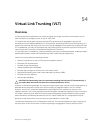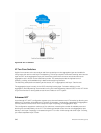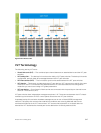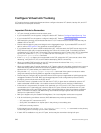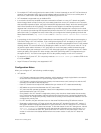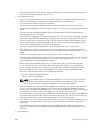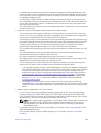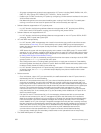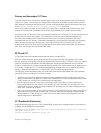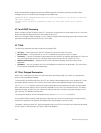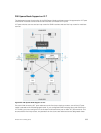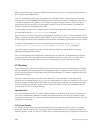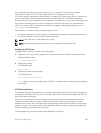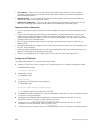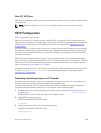
– All system management protocols are supported on VLT ports, including SNMP, RMON, AAA, ACL,
DNS, FTP, SSH, Syslog, NTP, RADIUS, SCP, TACACS+, Telnet, and LLDP.
– Enable Layer 3 VLAN connectivity VLT peers by configuring a VLAN network interface for the same
VLAN on both switches.
– Dell Networking does not recommend enabling peer-routing if the CAM is full. To enable peer-
routing, a minimum of two local DA spaces for wild card functionality are required.
• Software features supported on VLT physical ports
– In a VLT domain, the following software features are supported on VLT physical ports: 802.1p,
LLDP, flow control, IPv6 dynamic routing, port monitoring, and jumbo frames.
• Software features not supported with VLT
– In a VLT domain, the following software features are supported on non-VLT ports: 802.1x, DHCP
snooping, FRRP, ingress and egress QOS.
• VLT and VRRP interoperability
– In a VLT domain, VRRP interoperates with virtual link trunks that carry traffic to and from access
devices (refer to Overview). The VLT peers belong to the same VRRP group and are assigned
master and backup roles. Each peer actively forwards L3 traffic, reducing the traffic flow over the
VLT interconnect.
– VRRP elects the router with the highest priority as the master in the VRRP group. To ensure VRRP
operation in a VLT domain, configure VRRP group priority on each VLT peer so that a peer is either
the master or backup for all VRRP groups configured on its interfaces. For more information, refer
to Setting VRRP Group (Virtual Router) Priority.
– To verify that a VLT peer is consistently configured for either the master or backup role in all VRRP
groups, use the show vrrp command on each peer.
– Also configure the same L3 routing (static and dynamic) on each peer so that the L3 reachability
and routing tables are identical on both VLT peers. Both the VRRP master and backup peers must
be able to locally forward L3 traffic in the same way.
– In a VLT domain, although both VLT peers actively participate in L3 forwarding as the VRRP master
or backup router, the show vrrp command output displays one peer as master and the other
peer as backup.
• Failure scenarios
– On a link failover, when a VLT port channel fails, the traffic destined for that VLT port channel is
redirected to the VLTi to avoid flooding.
– When a VLT switch determines that a VLT port channel has failed (and that no other local port
channels are available), the peer with the failed port channel notifies the remote peer that it no
longer has an active port channel for a link. The remote peer then enables data forwarding across
the interconnect trunk for packets that would otherwise have been forwarded over the failed port
channel. This mechanism ensures reachability and provides loop management. If the VLT
interconnect fails, the VLT software on the primary switch checks the status of the remote peer
using the backup link. If the remote peer is up, the secondary switch disables all VLT ports on its
device to prevent loops.
– If all ports in the VLT interconnect fail, or if the messaging infrastructure fails to communicate
across the interconnect trunk, the VLT management system uses the backup link interface to
determine whether the failure is a link-level failure or whether the remote peer has failed entirely.
If the remote peer is still alive (heartbeat messages are still being received), the VLT secondary
switch disables its VLT port channels. If keepalive messages from the peer are not being received,
the peer continues to forward traffic, assuming that it is the last device available in the network. In
either case, after recovery of the peer link or reestablishment of message forwarding across the
interconnect trunk, the two VLT peers resynchronize any MAC addresses learned while
communication was interrupted and the VLT system continues normal data forwarding.
– If the primary chassis fails, the secondary chassis takes on the operational role of the primary.
• The SNMP MIB reports VLT statistics.
952
Virtual Link Trunking (VLT)




